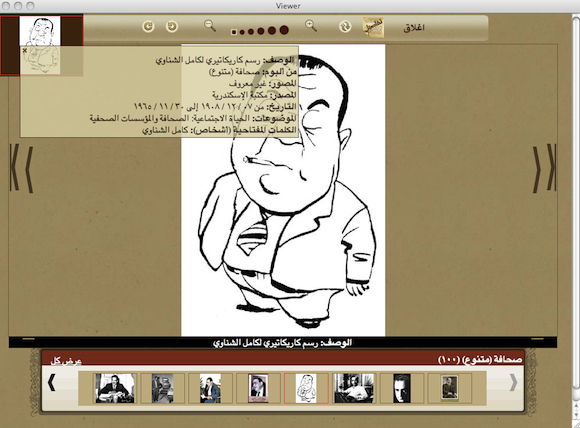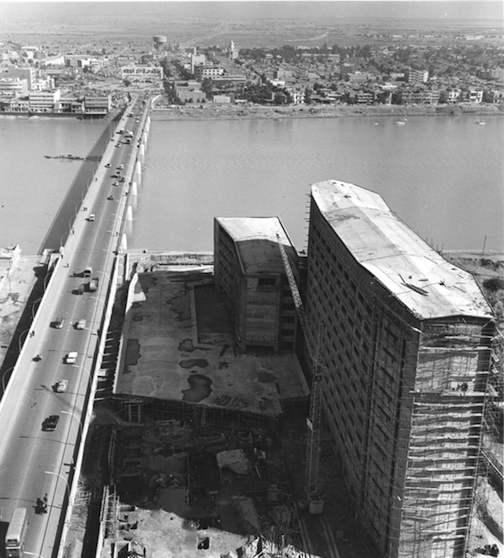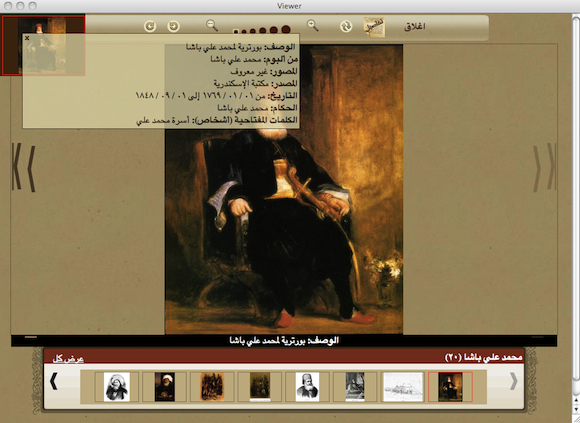Egypt has no sole institution devoted to the preservation and study of its one hundred fifty-year-old photographic history. Instead, photographs lurk in multiple private and institutional collections across the country. Plagued by decades of decreasing budgets, institutional neglect, and excessive gate-keeping, photographic collections share the fate of the archival collections of which they are part: uncatalogued and uncared for, often unknown even to their custodians, they become easy victims of loss, destruction, and theft.
The state, academic community, and general public in Egypt mostly understand photographs to be “images of something,” valued for their visual content and not as material objects embedded in social and cultural contexts. It is public knowledge that copyright is widely ignored in Egypt. But above and beyond the notion of legal ownership and authorship of a photograph, key information about the provenance of a given image is equally ignored, such as its creator, date of production, material properties, and source. Locally produced publications and, more recently, the web and Facebook overflow with vintage Egyptian photographs used as mere “images” -- orphans devoid of their materiality and original contexts.
But, in fact, widely diverging attitudes towards photographs and their value coexist in contemporary Egypt. Another view, especially in state institutions, undervalues photographs by portraying them as inferior historical documents. In other cases the materiality of a photograph occupies center stage in the process of assessing value. Cairo is the site of a vibrant and fully globalized market of vintage objects. Photographs represent an important part of this market and are much sought after by local and international collectors with prices sometimes rivaling those reached at international auctions. Indeed, that is where many photographs from Egypt end up. In yet other contexts, digital scans of photographs are traded and overvalued for their assumed evidentiary value. The Dar al-Hilal archive, for example, is known to have asked for exorbitant sums of money to allow researchers to simply see their photographic collections. Some collectors refuse to show their photographs to researchers while some dealers sell scans of old photos to private institutional collectors.
Assigning some objects value in one part of the world (or in certain contexts) but little or no value in another part of the world (or in other contexts) results in a unidirectional flow of artifacts. It also allows for claims of cultural superiority, in the form of “better knowledge,” flowing the opposite direction. Such a situation is not reducible to an East-West binary. Claims of providing “proper” care for Egyptian photographs (or for historical material in general) are mobilized equally among Egyptian actors eager to prove their nationalist credentials, and international funders, and often hide wider issues of a contest for power. The ambiguous terrain between seeing photographs as material objects and photographs as mere images may then be used to serve the interests of particular local or international actors, whether consciously or not.
A growing number of local and international actors claim that Egyptian (and more generally Middle Eastern) photographic heritage needs “saving.” For most local actors, the “failure of the state” remains a powerful paradigm for framing efforts to conserve this heritage. The situation in Egypt is thus cast as a drama: there is neglect and there is destruction (with the occasional murder), and there are heroic saviors.
The Alexandria Library
The Library of Alexandria positions itself as the key actor in saving Egypt’s cultural heritage. A Mubarak-era mega-project, the library’s construction and running budget is financed by foreign funding, especially UNESCO and a number of foreign governments and private donors. The library has an impressive reputation in Egypt and abroad through its combination of high-tech features [http://descegy.bibalex.org/index1.html], which offer digitally processed heritage for the delectation of local and international publics. Due to its combination of foreign expertise and local management outside of the state administration, it is much cherished by Egyptian middle class publics as a “new hope” for Egypt’s “culture.” While the corruption of its administration has been subject to much media coverage (most recently in this article on Jadaliyya), what goes on below the surface is, in many ways, more serious.
The library’s aura of worldliness, expertise, and overfunding translates into substantial assets vis-a-vis other domestic actors. It has allowed it to become a powerful player in the field of acquisitions and to lay its hands on underfunded local public institutions and archives in the city, whose collections the library takes over in order to “save” them. The Library’s aggressive acquisitions policy is known and felt on the market, and acknowledged by its own management.
But photographs as physical objects, as depository holdings, are nowhere to be found. The library catalogues and shows books, periodicals, and manuscripts. Other kinds of depository holdings are acknowledged in digital form only on the library’s flagship online database called “Memory of Modern Egypt.”
The database turns all currently held principles of archiving, preserving, cataloguing, digitizing, and digital-database-making upside down. Memory of Modern Egypt consists of arbitrary categories, in which individual entries display mere images, carriers of visual information deprived of materiality (medium, size, technique) and context of creation (author, provenance, source, or current holder).
Take, for instance, the photograph of a woman in a studio setting described as “The wife of Amin Yusuf Bek” [Figure 1]. This is as much as we are ever told. The provenance (masdar) line in the description field (the rectangle that opens over the image once we click on “details”) simply states, “Library of Alexandria.” In a similar vein, dozens of cartoons and ads under the category “press” are described and catalogued under their subject (the person or theme of the cartoon, or the product in the ad) without stating the author where appropriate, the publication, or date originally published [Figure 2]. Entries are often badly scanned and wrongly labeled. Thus a photo labeled “The Old Cairo-Helouan Road” in the original (unacknowledged) publication, here in the database becomes “Old Cairo” (Al-Qahira al-Qadima) which refers to an entirely different place [Figure 3].

[Figure 1. "The Wife of Amin Yusuf Bek." Source: Memory of Modern Egypt website.]

[Figure 2. "A Cartoon Drawing of Kamil al-Shennawi." Source: Memory of Modern Egypt webite.]

[Figure 3. "Al-Qahira al-Qadima." Source: Memory of Modern Egypt website.]
The entries also do not necessarily refer to any physical referent. In some cases they originate as scans of the library’s actual holdings, in other cases they are scans from (unacknowledged) books, or simply copied from the web. Thus a well-known painting by the Scottish artist David Wilkie held by the Tate in London appears in this database under the entry “Muhammad ‘Ali” [Figure 4]. The line for “author” says “unknown”; the “date” gives us the life of Muhammad ‘Ali, and the “source” we get is, again, “Library of Alexandria.”

[Figure 4. Muhammad `Ali Pasha. Source: Memory of Modern Egypt website.]
Withholding essential information, mislabeling, and claiming all entries as the property of “Library of Alexandria” is entirely consistent with the logic of understanding physical objects as mere images, and treating them as data. Such orphaned images remain utterly useless for research. As data they refer to nothing but themselves and the arbitrary categories of the database. At the same time, it remains impossible to locate the actual physical collections that the Library is known to have collected.
One would think that a botched database would devalue its institution. But not in this case, where heritage is understood numerically as data. While individual artifacts might be devalued and even destroyed, the overall political value of the library’s project remains untouched or even enhanced for its two key interlocutors: the global markets for cultural funding as well as, importantly, domestic middle class publics who view the library as an alternative to failed state curatorship of their heritage. Criticizing the library’s database is really not the point. Researchers are emphatically not its intended audience. The database was designed, and is managed, by informatics specialists.
To understand what (the hell) the Library of Alexandria is doing with its acquisitions, then, we have to exit the archive and examine the powerful interests that sustain the project as a whole. While one of these interests is now history—former president Mubarak’s self-positioning on the international scene as a source of tolerance and enlightenment in the region and embodied in the sphere of culture by developmentalist projects forcefully presided over by his wife, Suzanne—the other two are more resilient, and they work in tandem. One is the already mentioned infatuation of the Egyptian middle class with the library’s project. The other powerful interest is UNESCO. Since WWII, UNESCO has positioned itself as the champion and protector of “universal cultural heritage.” As it happens, the city of Alexandria plays a central role in this narrative. Its ancient past is cast as Europe’s mythical origin, a cradle of universalism and cosmopolitanism. The notion of “universal human culture,” for which the West functions as the savior and guardian, is obviously problematic due to its colonial origins and multifarious neo-colonial uses. Historically, the claim of a universal human culture has had as its nemesis nation-based notions of culture.
The Library of Alexandria’s model is politically and culturally powerful because it allows for an illusion of a “third way” between the two compromised paradigms of caring for cultural heritage, the colonial and the nationalist. From UNESCO’s perspective, the care for universal cultural heritage is here entrusted into local hands. These local elites strongly identify with the concept of universal cultural heritage. With a perception of themselves as both cosmopolitan and liberal, often in opposition to nationalist and religion-based notions of culture and identity, they understand their role as bringing “culture” to other Egyptians. Such elites play the double role of being “native Egyptian” towards their western interlocutors (in this case, sources of funding) as well as being “internationalist” or “global” towards the local scene, something that gives them no small amount of social and cultural authority. (This same logic applies to the Arab Image Foundation discussed in Part II of this essay, forthcoming.)
Egyptian curatorial elites who currently define what is considered “heritage” maintain their authority through powerful foreign funding and are supported by a host of developmentalist and civilizational narratives. The specific practice of “heritage-making” that they put in place then allows them to exploit the ambiguity between photographs-as-images and photographs-as-objects to their own advantage. Egyptian middle class publics and cultural elites are willing to accept the kind of digitally processed “heritage” served to them by the Library of Alexandria while in fact those who serve them this heritage are well aware of the difference between the value of the material artifact and its digital copy. While the library’s database treats photographs (and other historical artifacts) as mere images devoid of any material identity, some of the Library’s top administrators are collectors, long-term participants in the global market with vintage objects. Seen from this perspective, the Library of Alexandria appears as a black hole for artifacts. In a society inclined and encouraged to value photographs (and other historical material) for their content only, as mere carriers of visual information, digitalization enables new avenues for theft by making material objects literally invisible and practically superfluous. There are precedents for thinking the worst. Photographs originating from institutional archives in Egypt routinely appear on the private market, eventually enriching largely inaccessible private collections.
Archiving initiatives and concepts of photographic heritage currently emerging in the Middle East are shaped in very different ways than was the case over the past century. They are conceived along the lines of two models. One is a digitization model, as seen in the Library of Alexandria, which destroys artifacts in order to produce data. The second, which will be discussed in Part II of this essay, is a model of neoliberal fiefdoms where photographic heritage becomes the privilege of the select few. In both cases, public interest, in the form of open access, and research interests—the two aspects that framed public archives throughout the twentieth century—remain strikingly absent. [1]
[1] Parts of this research were conducted in cooperation with CULNAT; my thanks to Heba Farid and Clare Davies. My understanding of the role of UNESCO in the Alexandria Library’s project is much indebted to Beverly Butler’s Return to Alexandria (Left Coast Press, 2007). For further reading on Egyptian photographic history see Maria Golia, Photography and Egypt (Reaktion Books, 2009).